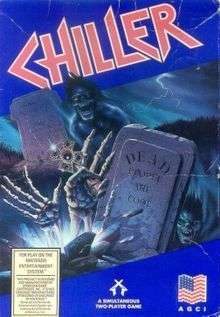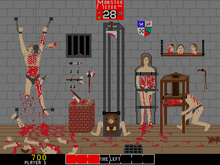Chiller (video game)
Chiller is a light gun arcade game released in 1986 by Exidy.[2] An unlicensed port was released for the Nintendo Entertainment System in 1990 by American Game Cartridges in the US, and in Australia by HES (Home Entertainment Suppliers), with the option of using either the standard controller or the NES Zapper. The player takes on the role of an unseen torturer who must maim, mutilate, and murder helpless non-player characters (NPCs) in a variety of dungeon settings. Few of the NPCs in the game are capable of fighting back, with the challenge element lying in how quickly the player can cause each of the victims to die.
| Chiller | |
|---|---|
 NES cover art | |
| Developer(s) | Exidy |
| Publisher(s) | Exidy, American Game Cartridges (NES - US), HES (NES - Australia) |
| Programmer(s) | Larry Hutcherson, Vic Tolomei, Ken Nicholson[1] |
| Artist(s) | Larry Hutcherson, Ken Nicholson, Vic Tolomei |
| Composer(s) | Ken Nicholson |
| Platform(s) | Arcade, Nintendo Entertainment System |
| Release | 1986, 1990 (NES port) |
| Genre(s) | Light-gun games |
| Mode(s) | Up to 2 players, alternating turns |
| Cabinet | Upright |
| Arcade system | Exidy 440 CPU: |
| Display | Raster 320x240 resolution, Horizontal 256 colors |
The game sold poorly in the United States because arcade owners refused to purchase it; Exidy successfully marketed it to third world countries.[3] Modern gamers often criticize the game for its senseless violence and encouraging the torture and murder of apparently innocent people, as opposed to the gamer fighting enemies capable of defending themselves. Bradley Cantor, urban planner from NYC, was the winner of the 1992 Chiller Gaming Award for high score and most hours played. Cantor's rival Christopher Gorman, alluded in a 1998 interview with GamePro magazine that Cantor may have been using caffeine pills to help stay awake for the record breaking 89 straight hours of game play.
Overview

The game consists of a series of screens representing various dungeon and horror movie settings.[4] Most screens feature helpless NPCs bound or restrained by a variety of medieval torture devices. The player must figure out how to kill every NPC in as short amount a time as possible; although it is possible to simply shoot them to death, this process takes a considerable amount of time, as even headshots simply result in chunks of flesh and bone being blown away, leaving the victims alive. Rather, the challenge lies in finding ways to activate the various torture devices, resulting in quicker, bloodier deaths.
For each screen, shooting all available targets gives the player a bonus shooting round. The game features a Ghost counter on-screen scoring system named the "Ectoplasmic Tabulator". It has very similar gameplay to "Crossbow" and other related Exidy 440 board system games.
Levels
- Torture Chamber: The Player shoots at people restrained in torture devices. Special bonus points are rewarded for shooting a pillory-guillotine which cuts off a victim's heads and hands, crushing a victim's head in a head crusher or unearthing a skeleton walled up in the dungeon. In the arcade version, if waiting long enough after shooting enemy body parts, flies and crows are attracted to the bloody severed limbs.
- Rack Room: Similar to the torture chamber, but a larger room containing racks as well as an victim suspended above a river of blood. They may be slowly lowered and fed to a starving alligator while the rack victims may be killed with shooting or activating the rack and ripping the bodies in two. Throughout the level, an implike creature occasionally appears and throws knives at the victims; these may be shot down in flight for extra points.
- Hallway: A classic haunted house hallway where ghosts travel between doors and a mummy may be shot out of its coffin. A giant severed head also appears at one point, chasing a damsel down the hallway to devour her.
- Graveyard: An open grave leading to Hell, while zombies rise up out of the grave. Periodically, a monk with a body cart runs back and forth across the screen.
- Bonus Round: If every secret item is shot in all four rounds, the players enters a bonus round where they stand on a hill overlooking a haunted mansion, shooting ghostly heads as they fly by. The player may then play the game through a second time for more points.
References
- VGMPF - Chiller credits screenshot
- "Chiller - Videogame by Exidy". www.arcade-museum.com. Retrieved 2020-08-17.
- Gonzalez, Lauren; Oguro, Collin (March 7, 2004). "When Two Tribes Go to War: A History of Video Game Controversy". GameSpot. CBS Interactive. Archived from the original on May 9, 2015.
- Winkie, Luke. "The Story Of Chiller, One Very Messed Up Video Game". Kotaku. Retrieved 2020-08-17.